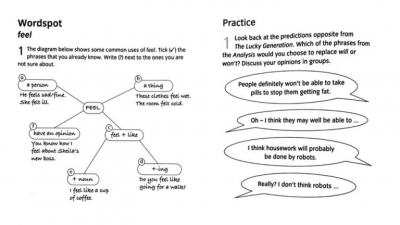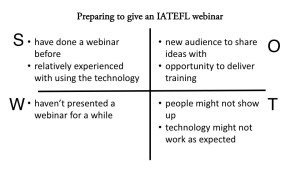On 21st October 2017, Mike Harrison presented the following IATEFL webinar:
Visualising your thinking – ideas for using graphic organisers with learners and teachers
Making decisions is difficult – whether that’s the case for you as a teacher trying to work out what you’ll teach in your next lesson (and how!) or your learners trying to plan what they’re going to write for an upcoming assignment. How can we simplify these everyday dilemmas? This webinar aims to show you how this is possible, by demonstrating a number of decision-making models and graphic organisers that can be used by teachers and learners to clarify their thoughts. Not just for making decisions, these models may also be useful as prompts for productive or reflective work in the classroom. Disclaimer – this is not a magic bullet that will resolve all your ELT-related worries – but if you come with an open mind, some pen and paper ready to work on some decisions, you are sure to pick up some ideas for your next class.
If you would like to watch the recording, you need to be a member of IATEFL (find out how to join). If you’re not a member, Mike has summarised ways to use one of the graphic organisers he described in his webinar. Over to Mike…
This blog post aims to introduce the idea of using visual methods of organising information with language learners and teachers and look at one particular example of graphic organiser and its potential applications for English language teaching.
What is a graphic organiser?
In simple terms, a graphic organiser is just a visual method for capturing and presenting information. They are not anything particularly new, and a cursory look through almost any ELT coursebook will show you that they are already widely used in the profession: ‘spider diagrams’ for presenting vocabulary and flowchart-esque conversation guides are two such examples.
One set of graphic organisers is categorised under the heading of decision-making models.These are frames for organising information and, according to Krogerus and Tschäppeler (2017: 6–7), have the following common features:
- They simplify a topic, issue, decision – they do not present everything concerned.
- They sum up a topic, issue or decision.
- They are visual, using shapes and lines to show relationships between things.
- They are simply methods – they are not a magic bullet and are only as good as the person using them.
A model for working out where you are
You may already be familiar with the acronym SWOT, or be able to guess the words its letters stand for: strengths, weaknesses, opportunities, and threats. SWOT analysis came out of a 1960s Stanford University study into Fortune 500 companies, and its aim was to help employees understand why they were doing what they were doing.
With the concept being over 50 years old, it’s fair to say that SWOT analysis is somewhat passé in project management. Indeed, teachers of business English or English for specific purposes may have let out a groan on reading the previous paragraph – you’ve probably examined more SWOT analyses than you can count. While this project management tool may have been a victim of ubiquity and overuse for some, it may still have some interesting applications for ELT practitioners.
SWOT analysis in action
Of course, there may be people reading this blogpost who are less familiar with this model. In this case, it is useful to consider an example. Here is my own SWOT analysis completed in preparation for leading an IATEFL webinar:
In completing this analysis, I considered different aspects of delivering an online presentation for teachers around the world. The advantages and disadvantages of undertaking this activity – I could share my ideas but would have to give up part of my weekend to do so. I could assess my own strengths and weaknesses as someone with a fair amount of experience giving workshops, both face-to-face and online.
Most importantly, I could consider the affordances granted by being involved with an IATEFL webinar. I could think about how I could positively impact on the practice of fellow ELT professionals.
SWOT analysis in ELT
So how could you use this model yourself? There are a variety of ways SWOT analysis could be useful in the language classroom. For example, you may ask your students to complete an analysis:
- before completing a functional task (e.g. buying a train ticket).
- before a lesson looking at a particular piece of language, like the present perfect form.
- at the beginning of the academic year or the start of their language course, assessing their English in terms of strengths and weaknesses, and its potential effect on their lives in terms of opportunities and threats.
- and there are probably other contexts you can think up.
Don’t rush this though – make sure you allow plenty of time to complete the SWOT analysis. This will give students a chance to properly assess where they are. And don’t do the SWOT analysis and just file it away to be forgotten – regularly review these analyses with your students, especially if they’re the kind that have been completed at the beginning of the course.
SWOT analysis for teachers?
What’s good for students could also benefit teachers! Why not try to do an analysis yourself:
- before teaching a particular area of language.
- before attending a workshop or starting a teacher training course.
- at the beginning and end of your teaching year.
Summary
Yes, SWOT analysis may be overused and some may think it is out of date, but that doesn’t mean we can’t make good use of this technique and model for our students and ourselves as teaching professionals. I invite you to try it out – you may be surprised at what you find yourself writing down about yourself and your experiences.
More models?
SWOT analysis is of course just one of many decision making models or graphic organisers. If you’d like to find out more, IATEFL members can watch the webinar recording to learn about models including the Superficial Knowledge Matrix and Crossroads Model.
References
Cunningham, S. & Moor, P. 1998. Cutting Edge Intermediate. Pearson: Harlow, UK
Cunningham, S. & Moor, P. 2005. New Cutting Edge Pre-Intermediate. Pearson: Harlow, UK
Krogerus, M. & Tschäppeler, R. 2017. The Decision Book. Profile: London
Mike Harrison is currently a member of the IATEFL Teacher Development Special Interest Group committee and helps keep the SIG’s website running at tdsig.org. Based in the UK, he has been a teacher, materials writer, and occasional teacher trainer. When not busy with ELT matters, he likes taking photographs. You can find him on Twitter @harrisonmike or on his blog.
Thank you to Mike for agreeing to write for the IATEFL blog.
If you’d like to write a blog post or present a webinar for us, please contact blog (at) iatefl (dot) org.
You can find out more about upcoming webinars on the IATEFL website. If you are an IATEFL member, you can access the recordings and slides from all of our webinars in the members’ area. If you’re not, you can join here.



